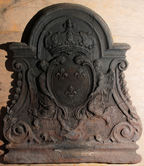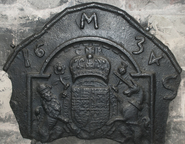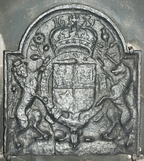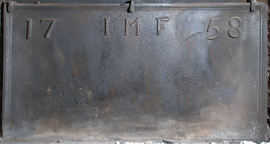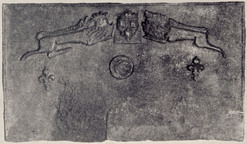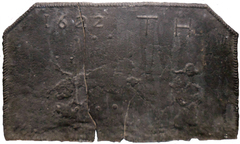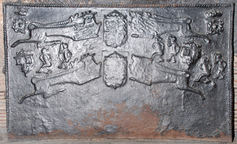-
940
Description: Upon a rectangular base plinth, wide scrolled side fillets with foliage about the scrolls and suspended bell flowers in chain above; central oval shield bearing three fleurs-de-lys supported by an angel on each side, and surmounted by a French royal crown; on top, an arch rising from horizontal moulding on each side.
Notes: Characteristic of designs illustrated by architects such as Daniel Marot.
Arms: France Royal
- Decoration tags:
- rectangular with round arch (shape)
- complex individual (edging)
- whole carved pattern
- planklines
- armorial
- royal
Manufactured: in the late-17th to early-18th century in France.
Current location: not known.
- Attached to series:
- Foreign armorial firebacks
-
1076
Description: Fragment; arched rectangular fireback with embattled, cavetto-moulded edging; English Stuart royal shield, Garter, crown and supporters, stemmed rose and stemmed thistle, respectively, to left and right of crown; initials CR above crown; all within a plain border, with short lengths of twisted rope edging containing, at the top, the initial M between a split date; initials (only S surviving) below date.
Notes: A Carolean composite fireback. The armorial fireback includes stylistic elements - the form of the unicorn and of the harp - identical to those on two series of firebacks dated 1618 and 1619, indicating the work of the same pattern-maker; its width is 490mm.
Inscription: M / 1634 / [?] S / C R
Arms: English Stuart royal (Charles I)
- Decoration tags:
- rounded arched (shape)
- rope (edging)
- carved pattern panels
- composite
- individual letters
- individual numbers
- heraldic
- armorial
- text
Manufactured: in 1634 possibly in the Forest of Dean area of England.
Current location: Black and White House Museum, The Old House, High Town, Hereford, Herefordshire, England.
-
1075
Description: Arched rectangular shape; cavetto-moulded edging (top and sides); English Stuart Royal arms, garter, supporters, crown and motto; altered date above crown.
Notes: This design, which probably dates from 1619, has been used to cast composite firebacks with a variety of altered dates ranging from 1629 to 1662.
Copies of this fireback are known.
Inscription: 1639 [illegible Garter and royal mottoes]
Arms: English Stuart royal
- Decoration tags:
- rectangular with round arch (shape)
- cavetto (edging)
- whole carved pattern
- individual numbers
- heraldic
- armorial
- text
Manufactured: in 1639 in the Forest of Dean area of England.
Current location: Black and White House Museum, The Old House, High Town, Hereford, Herefordshire, England.
-
902
Description: Rectangular with ogee moulded edging (top and sides); symmetrically spaced along the top, initials, IMF, between split date in well-defined characters.
Notes: The initials are believed to be of John Meers Fagg, who owned Blackford Farm, Herstmonceux, at that date. Fagg purchased three firebacks from Heathfield Furnace, Sussex, in September 1758, costing £4 10s. 6d. They were cast by Thomas Cavie, who was paid a shilling a piece (East Sussex Record Office, Brighton, SAS-RF/15/3/35, f.22). At least one other fireback is known with some of the same character set.
Inscription: 17 IMF 58
- Decoration tags:
- rectangular (shape)
- cyma reversa/ogee (edging)
- carved stamps
- individual letters
- individual numbers
- text
Manufactured: in 1758 at Heathfield Furnace in the Weald area of England.
Current location: in private hands, Herstmonceux, East Sussex, England.
- Attached to series:
- 1750s Heathfield series
-
1038
Description: Canted rectangular shape; edging formed of lengths of cross-cut dowel (top and sides); inscription across upper centre probably formed of thumb prints; the last digit of the date may be an incomplete 5 rotated left.
Notes: A crudely executed fireback; the cross-cut dowel used for the edging has not been noted on any other fireback.
Inscription: 16 wo 15[?]
- Decoration tags:
- rectangular with canted top corners (shape)
- cross-cut dowel (edging)
- simple stamps
- individual letters
- individual numbers
- text
Manufactured: in the early-17th century in the Weald area of England.
Current location: Herstmonceux Castle, Herstmonceux, East Sussex, England.
- Attached to series:
- Date & initials firebacks
-
1174
Description: Rectangular; twisted rope edging (top and sides); top centre, crowned shield bearing initials, KH, above a fleur-de-lys, between a leopard passant guardant sinister (on the left) and a leopard passant (on the right); below the rear legs of each leopard, a fleur-de-lys, each inclined slightly outwards at the top; beneath, and slightly to the left of the shield a circular stamp bearing the letter C.
Notes: One of the legs of the leopard on the right is missing, suggesting that the stamps, which appear complete on many firebacks, were well used and had been damaged; this suggests a relatively late use of these stamps. The style of fleur-de-lys is one of two seen on this series of firebacks. The fireback was formerly at Marden Hill House, Tewin, Hertfordshire.
Inscription: C
- Decoration tags:
- rectangular (shape)
- rope (edging)
- carved stamps
- heraldic
- royal
- text
- animals
- objects
Manufactured: in the mid- to late-16th century in the Weald area of England.
Current location: Hertford Museum, 18 Bull Plain, Hertford, Hertfordshire, England.
Museum number: HETFM2893.2 (part of the Hertford Museum museum group)
- Attached to series:
- Royal series
- Fleur-de-lys firebacks
-
1176
Description: Canted rectangular shape; twisted rope edging (top and sides); top left, date 1622; top right, initials T H.
Notes: The surface excrescences on the lower half of the fireback are likely to have resulted from the displacement of the casting sand by the pouring of the iron. Formerly at Marden Hill House, Tewin, Hertfordshire. There is no basis for the suggestion by Hertford Museum that this fireback might have been cast by a Thomas Hogge.
Inscription: 1622 T H
- Decoration tags:
- rectangular with canted top corners (shape)
- rope (edging)
- simple stamps
- carved stamps
- individual letters
- individual numbers
- text
Manufactured: in 1622 possibly in the Weald area of England.
Current location: Hertford Museum, 18 Bull Plain, Hertford, Hertfordshire, England.
Museum number: HETFM2893.1 (part of the Hertford Museum museum group)
- Attached to series:
- Date & initials firebacks
-
322
Description: Rectangular; rope edging (top and sides); two central crowned Tudor shields, one above the other, each with lion passant guardant sinister to the left, and lion passant to right; crowned, barbed, four-petalled rose in right and left corners; two crowned shields with KH in Lombardic characters above a fleur de lys, each irregularly placed between lions on left and right sides; three 'imps' with right arm raised, two on right and one on left between lions; two ‘imps’ with both arms lowered, one on each side in similar positions.
Notes: One of the legs of the leopards on the right is missing, suggesting that the stamp, which appears complete on many firebacks, was well used and had been damaged; this suggests a relatively late use of these stamps. The same heraldic charges can be seen on other firebacks, with other charges, forming the decoration on many other firebacks, suggesting they were the stock of one particular furnace.
Arms: Tudor royal arms of England
- Decoration tags:
- rectangular (shape)
- rope (edging)
- carved stamps
- heraldic
- armorial
- royal
- animals
Manufactured: in the mid- to late-16th century in the Weald area of England.
Current location: Hever Castle, Hever, Kent, England.
- Attached to series:
- Royal series
-
323
Description: Canted rectangle; simulated rope edging; otherwise plain.
Copies of this fireback are known.
- Decoration tags:
- rectangular with canted top corners (shape)
- simulated rope (edging)
- whole carved pattern
Manufactured: in the mid-20th century in England.
Current location: Hardy's Cottage, Higher Bockhampton, Dorset, England.
Museum number: 426390 (part of the National Trust museum group)
- Attached to series:
- Base boards
-
1271
Description: Rectangular shape; twisted rope edging (top and sides only); central initials, WS, in different character sets, between split date, also in different numeral sets, with a rectangular floral patera repeated at each end; below, and at a slight incline to the right, a horizontal twisted rope dividing the plate. The '5' of the date has been stamped in reverse.
Notes: A boldly cast fireback with disparate character styles. Probably acquired for the castle in the early-20th century during its refurbishment for Edward Hudson by Edwin Lutyens.
Inscription: 1 6 W S 7 5 [5 reversed]
- Decoration tags:
- rectangular (shape)
- rope (edging)
- simple stamps
- carved stamps
- individual letters
- individual numbers
- text
- plants
Manufactured: in 1675 in England.
Current location: Lindisfarne Castle, Holy Island, Northumberland, England.
Museum number: 511616 (part of the National Trust museum group)
- Attached to series:
- Miscellaneous stamp firebacks
